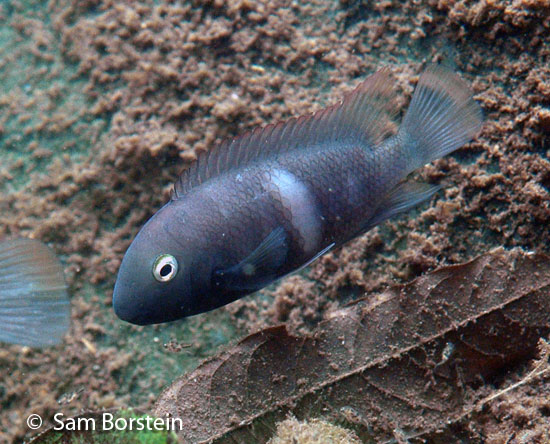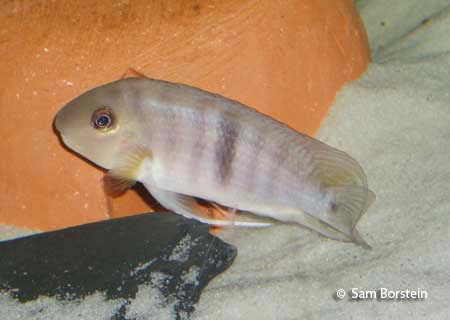Neetroplus nematopus
(Günther, 1867)
Neets, Poor Man's Tropheus
Synonyms: Neetroplus fluviatilis, N. nicaraguensis

Above: A wild female Neet in breeding color over fry photographed in the Rio Costa Rica, Costa Rica. Photo by Sam Borstein.
Etymology:
Genus- neo= new (Greek), etro= belly (Greek), pelos= stiff (Greek). Neetroplus nematopus is a new world cichlid, so it means new world Etroplus, a fish that has similar fin structure.
Species-nematopus= nemato= thread (Greek), pus= foot (Greek). Referring to the long pelvic fins.
Intro:
Neetroplus nematopus is a monotypic species, first typed by Günther in 1867. Neets are very interesting fish to keep. These fish, are possibly pound for pound one of the meanest cichlids. This small growing cichlid can wreck havoc on a tank if the owner doesn't know much about the fish.
Although this fish is far from colorful, the fish is very popular because of its breeding behavior.
This fish is known as the Neet, short for Neetroplus, and the Poor Man's Tropheus. It gets the Poor Man's Tropheus name because the diet, behavior, and body shape they have are similar to Tropheus.
Another interesting tidbit about this fish is that in the wild Neetroplus nematopus is a major predator of Hypsophrys nicaraguensis fry. Hypsophrys nicaraguensis have been observed defending Parachromis dovii fry, the main predator of Neetroplus nematopus. It's hypthesized that by helping defend Parachromis dovii fry, there is a greater chance that more Parachromis dovii will reach maturity and more of the Neetroplus nematopus will be eaten, leaving Hypsophrys nicaraguensis with fewer Neetroplus nematopus to defend against.
*Note*- As of August of 2007, Neetroplus has been put into the genus of Hypsophrys. This change was due to the skull structure similarities between the two species. On this site, I still have this fish in Neetroplus because I believe it should be in this genus because of behavior differences and spawning differences. One key factor I see, besides general breeding behavior, is the fact that the eggs of Hypsophrys nicaraguensis are non-adhesive. There are other reasons I have for the keeping of this cichlid in the genus Neetroplus, but that is the major one. I don't think that saying the fish share a similar bone and that they were in sister genera warrants the merging of the two genera. Sure they probably came from a common ancestor, but that doesn't mean they should be in the same genus.
Distribution:
Neetroplus nematopus is found in both rivers and lakes throughout Nicaragua and Costa Rica.
Size, Maturity, and Sexual Dimorphism:
Size: Males- 4.5 inches, Females- 3 inches
Maturity: 2.5 inches
Sexual Dimorphism: Males are larger than females and attain trailers to the anal, pelvic, and dorsal fins. As far as color, there are no distinguishing characteristics between the two sexes. Males sometimes have a larger nuchal hump, but this should not be used as a definite characteristic.

Above: A male Neetroplus nematopus. Photo by Sam Borstein.
Care:
Neets are quite easy to care for. The only thing is managing aggression. Mike Garibaldi, a GCCA member told me this when I got my pair: "these fish are plain terrors and downright killers". Pound for pound, this may be the toughest Central American cichlid.
Pair bonds are usually very strong between the fish, but other fish are on the hit lists of these guys. Be wise with tank occupants. This fish is a cave spawner, so add caves for the fish to hide in.
Diet:
Neets are vegetarians, and in the wild graze on algae. In captivity, they should be fed a good amount of fibrous foods, but can also be fed foods with protein, which will help condition the females, and produce eggs.
Breeding:
Breeding Neets is fun. I started with a breeding pair, but if you have a group of 6-8, don't worry, they will kill each other down to a pair. These fish form good pair bonds.
I had trouble breeding these guys at first. Besides the need for females to be well conditioned before they spawn, the fish also need target fish, a fish that the pair can take their aggression out on. I used rainbow fish, as they are big bodied, and fast. This worked, and breeding behavior finally began.
You know these fish are about to breed, when the female turns dusky gray. When this fish breeds, its colors reverse. Instead of being gray with a black bar, they are black with a gray bar. My females were always the first to change color, and the males started to change when the fry were free swimming.

Above: A wild female Neet in breeding color in the Rio San Jose, Costa Rica. Photo by Sam Borstein.
When the fish spawn, they lay about 40-50 eggs, which are huge in size when comparing them to other Central Americans. The eggs are also an interesting Olive green color. The eggs hatch out in about 5 days, and are free swimming in about 8 days. The fry are over 1/4 of an inch long when free swimming, and grow fast, especially on baby brine shrimp. Let algae grow in the tank, so the fry can constantly graze. Within 2 weeks, they were 3/4 of an inch long and exhibiting the color pattern of the adults, a black bar on their gray body.
Parental care is amazing. The parents will go after you if you stick your hand in the tank. These suckers are fearless. I had my pair take care of fry for 2 1/2 months before I separated them, amazing!
Conclusion:
Neets are neat and one of my all time favorite fish I've ever kept. I highly recommend any Central American Cichlid lover try these. Also, if you don't have many large tanks, and want a Central American, try this fish. Just know what you are getting yourself into.
References:
- Bussing, W.A. (1998) Peces de las aguas continentales de Costa Rica. Revista de Biología Tropical, 46, 1–468.
- Günther, A. (1867) Memoir on the Fishes of the States of Central America, founded upon specimens collected in the fresh and marine waters of various parts of that country by Messrs. Salvin and Godman and Capt. J.M. Dow. Proceedings of the Zoological Society of London, 1866, 600–604.
- Schmitter-Soto, J.J., 2007. A Systematic Revision of the Genus Archocentrus (Perciformes:Cichlidae), with the Description of Two New Genera and Six New Species. Zootaxa 1603, 1-76.
